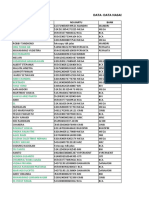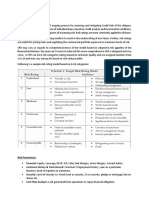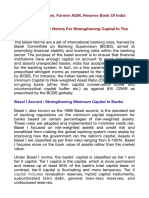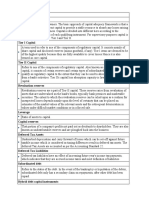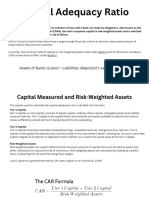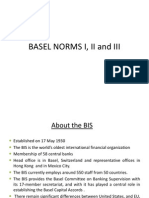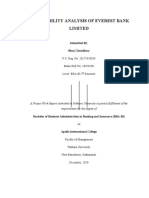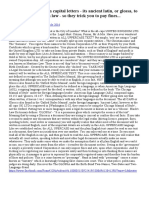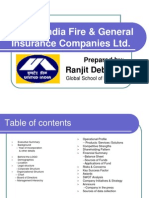Basel Norms in Banking Sectors
Basel Norms in Banking Sectors
Uploaded by
Saikat ChatterjeeCopyright:
Available Formats
Basel Norms in Banking Sectors
Basel Norms in Banking Sectors
Uploaded by
Saikat ChatterjeeCopyright
Available Formats
Share this document
Did you find this document useful?
Is this content inappropriate?
Copyright:
Available Formats
Basel Norms in Banking Sectors
Basel Norms in Banking Sectors
Uploaded by
Saikat ChatterjeeCopyright:
Available Formats
The Basel Committee on Banking Supervision was established in 1974, by the Bank of International Settlements (BIS).
An international organization founded in Basel, Switzerland in 1930 to serve as a Bank for Central banks.
Committee consisting of members from each of the G10 countries. It is represented by central bank governors of each of the G10 (developed) countries.(NOW 13)
Thirteen industrialized Nations that meet on an annual basis to consult each other on international financial matters.
The member countries are: France, Germany, Belgium, Italy, Japan, the Netherlands, Sweden, the United Kingdom, the United States and Canada, with Switzerland, Luxembourg, Spain It meets regularly 4 times a year.
Basel Committee on Banking Supervision (BCBS) framework on Capital Adequacy takes into account the elements of credit risk to strengthen the capital base of banks. RBI decided in April 1992 to introduce a risk asset ratio system for banks in India as a capital adequacy measure.
The basic approach of capital adequacy framework is that a bank should have sufficient capital to provide a stable resource to absorb any losses arising from the risks in its business.
For supervisory purposes capital is split into two categories: Tier I and Tier II. These categories represent different instruments quality as capital:
Tier
I Capital consists:
Equity Capital (Shareholders' Funds) Disclosed Reserves:
Premium over shares, Retained earnings, Legal reserve
It is a banks highest quality capital because it is fully available to cover losses.
Legal Reserve:
Legal reserves are the only assets that are permitted by government regulations.
Divided into The two asset categories: Required Reserve (Vault cash & Reserve deposits ) Excess Reserve (Reserve for loan purposes)
Vault Cash (Required Reserve)
Paper bills and metal coins kept on the bank premises, both the vault and teller drawers. To satisfy currency withdrawal demands of depositors. Vault cash is not part of the official M1 money supply.
M1 includes only the paper bills and metal coins that is in circulation and held by the nonbank public.
Reserve deposits regulators require.
are
the
one
that
These are deposits that banks keep with the Reserve Bank Of India System. Required reserves are specified as a fraction of outstanding deposits--usually about 3 percent -15 percent
Any legal (or total) reserves over and above those required by regulators are excess reserves. These excess reserves are used for loans, which makes them exceedingly important to the banking industry. Holding excess reserves means loss of interest revenue.
Tier II capital Consists:
Undisclosed reserves Revaluation reserves General provisions Subordinated debt Hybrid Instruments. This capital is less permanent in nature.
The loss absorption capacity of Tier II capital is lower than that of Tier I capital.
Undisclosed reserves are not common.
They are accepted by some regulators where a bank has made a profit but this has not appeared in normal retained profits or in general reserves of the bank. Many countries do not accept this as an accounting concept or a legitimate form of capital
Revaluation reserve is created when a bank
has an asset revalued and an increase in value is brought to account.
Example: A bank owns the land and building of its head-offices and bought them for $100 a century ago. A current revaluation is very likely to show a large increase in value. The increase would be added to a revaluation reserve.
Adequate care must be taken to ensure that sufficient provisions have been made to meet all known losses and foreseeable potential losses before considering as part of Tier II Capital.
Have some characteristics of both EQUITY.
DEBT and
These are close to equity in nature, in that they are able to take losses on the face value without triggering a liquidation of the bank, they may be counted as capital.
Example: Preferred stock usually carries no voting rights but may carry a dividend and may have priority over common stock in the payment of dividends and upon liquidation.
Such debt is referred to as subordinate, because the debt providers (the lenders) have subordinate status in relationship to the Normal debt. A typical example for this would be when a promoter of a company invests money in the form of debt, rather than in the form of stock. Subordinated debt has a lower priority than other bonds of the issuer in case of liquidation during bankruptcy. It has minimum maturity period is 5 years.
Credit risk is most simply defined as the potential that a banks borrower or counterparty may fail to meet its obligations in accordance with agreed terms.
For most banks, loans are the largest and the most obvious source of credit risk; however, other sources of credit risk exist throughout the activities of a bank like inter-bank transactions, trade financing, foreign exchange transactions,
Market Risk is the risk to the banks earnings and capital due to changes in : Market level of interest rates Prices of securities Foreign exchange Equity Prices
The first accord was the Basel I. It was issued in 1988 and focused mainly on credit risk. Banks with international presence are required to hold capital equal to 8 % of the risk-weighted assets. Carrying risk weights of zero (for glits bond ), ten, twenty, fifty, and up to one hundred percent ( Corporate debt).
It standardizes risk-based capital requirements for banks across countries as per following measurement:
A measure of a bank's capital. It is expressed as a percentage of a bank's risk weighted credit exposures. CAR = Tier I + Tier II Risk Weighted Assets
Risk weighted assets is a measure of the amount of a banks assets, adjusted for risk.
It can be arrived simply by multiplying it with factor that reflects its risk. Low risk assets are multiplied by a low number, high risk assets by 100% (i.e. 1).
Suppose a bank has the following assets:
Rs. 1bn in gilts Rs. 2 bn secured by mortgages Rs. 3bn of loans to businesses. The risk weights used are: 0% for glits (a risk free assets) 50% for mortgages 100% for the corporate loans. The bank's risk weighted assets are 0 1bn + 50% 2bn + 100% 3bn = 4bn.
The main use of risk weighted assets is to calculate Tier1 and Tier 2 capital adequacy ratios. If its capital is 10% of its assets, then it can lose 10% of its assets without becoming Insolvent. (Insolvency is simply being unable to pay liabilities; Liabilities > Assets and liquidate it.
Basel II came into being in 2004.
Basel II is based on 3 pillars: (i) Minimum capital requirements, (ii) Supervisory review of an institution's capital adequacy and internal assessment process; (iii) Market discipline through effective disclosure to encourage safe and sound banking practices.
Pillar 1 includes 3 risks now, operational risk + credit risk + market risk to meet international standards.
Commercial banks in India adopt Standardized Approach (SA) for credit risk. Standardized Approach, the rating assigned by the eligible external credit rating agencies, largely supports the measure of credit risk.
Banks rely upon the ratings assigned by the external credit rating agencies chosen by the RBI for assigning risk weights for capital adequacy purposes. As: a) Credit Analysis and Research Ltd. b) CRISIL Ltd. c) FITCH Ltd. and d) ICRA Ltd. International credit rating agencies : a) Fitch; b) Moody's; and c) Standard & Poor's.
Banks must disclose the names of the credit rating agencies that they use for the risk weighting of their assets.
The risk weights associated with the particular rating grades as determined by RBI for each eligible credit rating agency as well as the aggregated risk weighted assets.
Pillar 2: Supervisory Review Process (SRP)
The establishment of suitable risk management systems in banks and their review by the supervisory authority (RBI). As:
In terms of the Pillar 2 requirements of the New Capital Adequacy Framework, banks are expected to operate at a level well above the
minimum requirement.
Pillar 3: Market Discipline seeks to achieve
increased transparency through disclosure requirements tor banks.
expanded
For such comprehensive disclosure, IT structure must be in place for supporting data collection and generating MIS which is compatible with Pillar 3 requirements.
Basel II Tier I CRAR = Tier I capital / (Credit Risk RWA + Operational Risk RWA + Market Risk RWA)
Basel II Total CRAR = Total capital / (Credit Risk RWA + Operational Risk RWA + Market Risk RWA) RWA - risk weighted assets
Capital to Risk Weighted Assets Ratio (CRAR) of 8% and Tier I capital of 6%.
The RBI has stated that Indian banks must have a CRAR of minimum 9%, effective March 31, 2009.
The Government of India has stated that public sector banks must have a capital cushion with a CRAR of at least 12%, higher than the threshold of 9% prescribed by the RBI.
Failure to adhere to Basel II can attract RBI action including restricting lending and investment activities. However, private sector banks as well as public sector banks are likely to comply with Basel II norms by March 31, 2009
In order to strengthen risk management mechanism: Indian banks should have minimum Tier-I capital of 7 percent of risk-weighted assets.
Total capital must be at least 9 percent of risk-weighted assets.
Besides, it has also suggested for setting up of the capital conservation buffer in the form of Common Equity of 2.5 per cent of RWAs.
Implementation of the minimum capital requirements will begin from January 2013 and should be fully implemented by March 31, 2017. S&P expects all banks that it rates in India to meet the RBI's requirements within the stipulated timeframe
Currently, RBI follows Basel II norms: As Banks are required to maintain a minimum Capital to Risk weighted Assets Ratio (CRAR) of 9 per cent. Tier 1 capital should be at least 6 per cent of risk weighted assets
On aggregate, banks are comfortably placed in terms of capital adequacy, but a few individual banks may fall short due to implementation of Basel III norms.
You might also like
- AMS Group 8 Written ReportDocument29 pagesAMS Group 8 Written ReportKatarina LiNo ratings yet
- Basel NormsDocument23 pagesBasel NormsPranu PranuNo ratings yet
- Laki - LakiDocument80 pagesLaki - LakiRachman MercyNo ratings yet
- Format of Final Accounts ACC 415 UITMDocument2 pagesFormat of Final Accounts ACC 415 UITMAifaa ArinaNo ratings yet
- Basel 3Document3 pagesBasel 3NITIN PATHAKNo ratings yet
- Basel Norms Npa Financial Inclusion 28Document7 pagesBasel Norms Npa Financial Inclusion 28AKSHAY SANTHOSH SANTHOSH SACHARIASNo ratings yet
- Capital Adequacy 148Document11 pagesCapital Adequacy 148Bindal Heena100% (1)
- On Capital AdequacyDocument46 pagesOn Capital Adequacymanishasain75% (8)
- BASEL Committee NotesDocument10 pagesBASEL Committee NotesChandra MouliNo ratings yet
- Basel AccordsDocument13 pagesBasel AccordsMani GantenapalliNo ratings yet
- Basel 3Document32 pagesBasel 3Venkat SaiNo ratings yet
- Basel Norms: Basel Is A City in Switzerland Which Is Also The Headquarters of Bureau ofDocument6 pagesBasel Norms: Basel Is A City in Switzerland Which Is Also The Headquarters of Bureau ofTwinkal chakradhariNo ratings yet
- Car & BaselDocument7 pagesCar & BaselParimal MaldhureNo ratings yet
- MBM Slides Set 4 - August 26 2022Document61 pagesMBM Slides Set 4 - August 26 2022Mukul BaviskarNo ratings yet
- Basel 1and 2 NewDocument28 pagesBasel 1and 2 NewnipuntrikhaNo ratings yet
- Unit 4 - Capital - Risk, Adequacy, RegulationDocument30 pagesUnit 4 - Capital - Risk, Adequacy, RegulationAsankhya DeepNo ratings yet
- Economics Glossary PDFDocument9 pagesEconomics Glossary PDFSK PNo ratings yet
- Capital Adequacy RatioDocument2 pagesCapital Adequacy RatiomanoramanNo ratings yet
- Crr&BaselaccordsDocument4 pagesCrr&BaselaccordsFarah KhanNo ratings yet
- What Is Capital Adequacy of Banks and Financial Institutions?Document5 pagesWhat Is Capital Adequacy of Banks and Financial Institutions?Raymond mmuNo ratings yet
- Capital Adequacy RatioDocument3 pagesCapital Adequacy Ratioawadesh44rai9983No ratings yet
- Capital Adequacy RatioDocument7 pagesCapital Adequacy Ratiokumar_rajeshNo ratings yet
- B&I Unit 3Document14 pagesB&I Unit 3saisri nagamallaNo ratings yet
- Commercial Banking NotesDocument5 pagesCommercial Banking NotesabhijeetmohanNo ratings yet
- Glossary: Capital Earnings Funds and Investment Asset Securitisation Nds-Om Web HomeDocument16 pagesGlossary: Capital Earnings Funds and Investment Asset Securitisation Nds-Om Web HomeSanjeet MohantyNo ratings yet
- Risk Management in Banks and Basel - II ComplianceDocument35 pagesRisk Management in Banks and Basel - II ComplianceSrinivas AcharNo ratings yet
- Interpreting The IRB Capital Requirements in Basel IIDocument31 pagesInterpreting The IRB Capital Requirements in Basel IIcriscinca100% (1)
- Khalsa College For Women: Bank Management Assignment Topic-Capital AdequacyDocument6 pagesKhalsa College For Women: Bank Management Assignment Topic-Capital AdequacypalakNo ratings yet
- Capital Adequacy RatioDocument12 pagesCapital Adequacy RatioVinit Tulaskar100% (1)
- Basel I To Basel 3.1 Norms For Strengthening CapitalDocument13 pagesBasel I To Basel 3.1 Norms For Strengthening CapitalSo CheataNo ratings yet
- Capital Adequacy Ratio - ReportDocument11 pagesCapital Adequacy Ratio - ReportAllex JackNo ratings yet
- Basel IiDocument26 pagesBasel IipallavivyasNo ratings yet
- Capital Earnings Funds and Investment Asset Securitisation HomeDocument7 pagesCapital Earnings Funds and Investment Asset Securitisation HomeKumar PsnNo ratings yet
- Ibps Po Interview PreparationDocument27 pagesIbps Po Interview PreparationArham RahiNo ratings yet
- Capital Capital FundsDocument10 pagesCapital Capital Fundsbhau_20No ratings yet
- Capital Adequacy Ratio For Banks - 1Document9 pagesCapital Adequacy Ratio For Banks - 1Jignesh NayakNo ratings yet
- Basel NormsDocument33 pagesBasel NormsPaavni SharmaNo ratings yet
- Basel Norms in Risk Management FinanceDocument9 pagesBasel Norms in Risk Management Financeofficetrichy05No ratings yet
- Capital Adequacy in Indian Banks 3Document43 pagesCapital Adequacy in Indian Banks 3arshita sharmaNo ratings yet
- Sesi 6Document35 pagesSesi 6smpurnolietaniaNo ratings yet
- Banking Managment System ThesisDocument59 pagesBanking Managment System Thesisaliramram25% (4)
- Fodder Material For Phase 2 For SEBI Grade A 2020: WWW - Edutap.Co - in Hello@Edutap - Co.InDocument13 pagesFodder Material For Phase 2 For SEBI Grade A 2020: WWW - Edutap.Co - in Hello@Edutap - Co.InMega MindNo ratings yet
- task 4Document5 pagestask 4Thảo PhươngNo ratings yet
- Capital Adequacy CalculationDocument9 pagesCapital Adequacy CalculationSyed Ameer HayderNo ratings yet
- Insights - A Journey From Basel II To Basel IVDocument12 pagesInsights - A Journey From Basel II To Basel IV0399shubhankarNo ratings yet
- Capital Capital FundsDocument12 pagesCapital Capital FundsDrKhalid A ChishtyNo ratings yet
- Basel II Vs Basel III NormsDocument3 pagesBasel II Vs Basel III NormsNaman Sharma0% (1)
- UNIT IV Banking Theory Law and PracticeDocument8 pagesUNIT IV Banking Theory Law and PracticeLoganathan KrishnasamyNo ratings yet
- Cherian Varghese SpeechDocument10 pagesCherian Varghese Speechaquarianmansi2212No ratings yet
- Economic 9Document34 pagesEconomic 9bhubrijeshkNo ratings yet
- Capital Capital FundsDocument11 pagesCapital Capital FundsSantosh Kumar BarikNo ratings yet
- Chapter 10 (Banking Regulation and Management)Document51 pagesChapter 10 (Banking Regulation and Management)2023436742No ratings yet
- MZ 1Document21 pagesMZ 1Anh Nguyễn MaiNo ratings yet
- Glossary PDFDocument8 pagesGlossary PDFkumarsanjeev.net9511No ratings yet
- Capital Adequacy RatioDocument5 pagesCapital Adequacy Ratiomeirna.puspitaNo ratings yet
- Capital Adequacy Ratios For BanksDocument36 pagesCapital Adequacy Ratios For BanksRezaDennyzaSatriawanNo ratings yet
- Basel Norms I, II and IIIDocument30 pagesBasel Norms I, II and IIIYashwanth PrasadNo ratings yet
- Basel NormsDocument9 pagesBasel Normstanushree guptaNo ratings yet
- Risk Management in Banks: Paper No XxviDocument26 pagesRisk Management in Banks: Paper No XxviRadhika GuptaNo ratings yet
- Economy_Handout_Class-9Document3 pagesEconomy_Handout_Class-9rramanan2002No ratings yet
- Interpreting The IRB Capital Requirements in Basel IIDocument34 pagesInterpreting The IRB Capital Requirements in Basel IIcriscincaNo ratings yet
- Source Document of AccountancyDocument7 pagesSource Document of AccountancyVinod GandhiNo ratings yet
- 5th Sem ReportDocument52 pages5th Sem ReportDilip singhNo ratings yet
- Midxix Prestige Savings FormDocument2 pagesMidxix Prestige Savings FormKartik ShuklaNo ratings yet
- Chapter II - Organizational ProfileDocument16 pagesChapter II - Organizational ProfileSudarsun sunNo ratings yet
- UST Golden Notes - Banking LawsDocument20 pagesUST Golden Notes - Banking LawsAntrex Guro100% (1)
- A Study On Quality of Work LifeDocument34 pagesA Study On Quality of Work LifeRaval ViralNo ratings yet
- r178067n Final Dissertation 14 December 2022 Locadia NyokaDocument129 pagesr178067n Final Dissertation 14 December 2022 Locadia NyokatsungainyokaNo ratings yet
- E-Receipt For State Bank Collect PaymentDocument1 pageE-Receipt For State Bank Collect PaymentAnjaney KumarNo ratings yet
- ReadingC1 USA PDFDocument96 pagesReadingC1 USA PDFJhonny Sam VivasNo ratings yet
- Women Empowerment Through SHGS: Roshni RawatDocument7 pagesWomen Empowerment Through SHGS: Roshni RawatBHARAT REDDY VAKANo ratings yet
- Investment Management Research PapersDocument5 pagesInvestment Management Research Papersfjluthulg100% (1)
- Ratio AnalysisDocument50 pagesRatio AnalysisSweetie Arshad AliNo ratings yet
- Evidence of FundsDocument3 pagesEvidence of FundsFarukh AlamNo ratings yet
- Why Your Name Is in Capital LettersDocument1 pageWhy Your Name Is in Capital Letterskayvan1667% (3)
- Ranjit's United India Fire & General Insurance Companies LTDDocument42 pagesRanjit's United India Fire & General Insurance Companies LTDKristin SmithNo ratings yet
- Gen Math Final ExamDocument4 pagesGen Math Final ExamMARITESS COLLADONo ratings yet
- Bajaj Allianz General Insurance Company Branch Offices List With AddressDocument38 pagesBajaj Allianz General Insurance Company Branch Offices List With AddressPraveen MadineniNo ratings yet
- Norkis v. CADocument2 pagesNorkis v. CAVince MontealtoNo ratings yet
- Midterm Exam FABM 2Document2 pagesMidterm Exam FABM 2Vee Ma100% (2)
- Chapter 3Document21 pagesChapter 3Annalyn MolinaNo ratings yet
- AICTE Activity Points Program Report by Bikash GiriDocument41 pagesAICTE Activity Points Program Report by Bikash GiridiwanisumanNo ratings yet
- In Re: Payment Card Interchange Fee and Merchant Discount Antitrust Litigation, Memorandum and Order On Motion For SettlementDocument55 pagesIn Re: Payment Card Interchange Fee and Merchant Discount Antitrust Litigation, Memorandum and Order On Motion For SettlementFindLawNo ratings yet
- Chapter Five Regulation of FM AND FIDocument24 pagesChapter Five Regulation of FM AND FINatnael AsfawNo ratings yet
- Avail NACH 3 PDFDocument1 pageAvail NACH 3 PDFManjunath ManjunathNo ratings yet
- Home Loan Project Final (Arun)Document64 pagesHome Loan Project Final (Arun)Munjaal RavalNo ratings yet
- Kisala - The Effect of Credit Risk Management Practices On Loan Performance in Microfinance InstitutionsDocument69 pagesKisala - The Effect of Credit Risk Management Practices On Loan Performance in Microfinance Institutionsjhomar jadulan100% (3)



